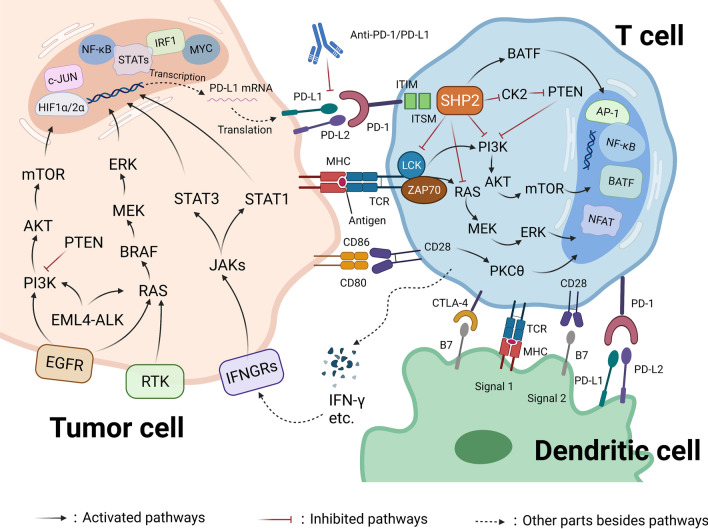Fig. 1.
PD-1/PD-L1 interaction mediated T cell inhibition. Factors that regulate PD-L1 expression mainly includes (1) genomic aberrations, (2) microRNA-based control, (3) oncogenic transcription factors and pathways and (4) posttranslational regulation and transport. The RAS/MEK/ERK, PI3K/Akt/mTOR, JAK/STATs signaling and TLRs/IKKs pathways are the main pathways regulating PD-L1 expression. IRF1, STATs, MYC, NF-κB, c-Jun and HIF1α/2α are the main downstream transcription factors. Posttranslational modifications of PD-L1 include phosphorylation, ubiquitination, glycosylation and palmitoylation. Induction of PD-L1 by cytokines, such as IFN-γ, is considered a secondary mechanism. Activation of PD-1/PD-L1 signaling leads to the recruitment of the phosphatase SHP-2 to the C-terminal of the ITSM, which downregulates the RAS-MEK-ERK and PI3K-Akt-mTOR pathways and attenuates LCK-induced phosphorylation of ZAP70. In addition, SHP-2 induces the expression of BATF, which inhibits the expression of some effector genes. In general, activation of PD-1/PD-L1 signaling leads to the inhibition of T cell proliferation and activation. Activation of PD-1/PD-L1 can be blocked by anti-PD-1/PD-L1 antibodies. In addition, APCs uptake tumor antigens and regulate T cell responses through the interaction between major MHC and TCRs. APCs (dendritic cells) regulate T cell activity through modulating the interaction between PD-L1/PD-L2 and PD-1 and the interaction between B7 and CD28. CTLA-4 is a negative regulator of costimulation that is activated in the recognition of specific tumor antigens presented by APCs

